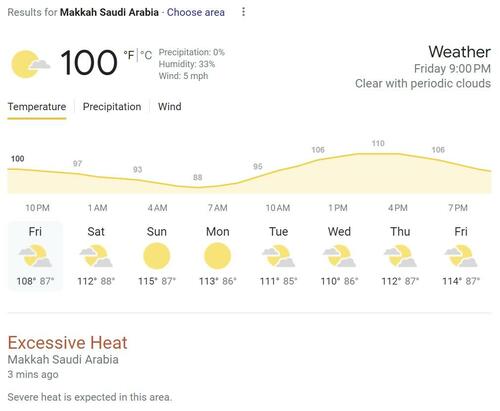Oven-Like Conditions Result In Over 1,000 Deaths During Hajj In Saudi Arabia
We explained earlier that the Hajj is the final of the five pillars of Islam, and requires that every Muslim who is of adult age complete the religious pilgrimage to Mecca once in their lifetime, so long as they are financially and physically able. This means huge numbers descended on the city which is home to the shrine of the Kaaba in Saudi Arabia each year. More than 1.8 million people attended Hajj in 2023, approaching pre-pandemic levels. According to Saudi officials, they expect the figure to exceed the two million mark this year.
Not only are the massive crowds a problem, but this year the Saudi city is under an excessive heat warning, with highs at times having reached between 110 and 115°F during the day, and 100°F even at night. This has resulted in what could be a record amount of heat injuries and deaths by the pilgrimage season’s end. On Monday the Saudi weather service recorded a temperature of 125 degrees Fahrenheit at Mecca’s Grand Mosque.
The AFP reported Thursday that deaths from heat-related causes has surpassed 1,000 people amid the extreme conditions.
“The new deaths reported Thursday included 58 from Egypt, according to an Arab diplomat who provided a breakdown showing that of 658 Egyptians who passed away, 630 were unregistered pilgrims,” AFP writes. Indonesia also reported a high number of heat-related casualties.
In total ten countries have reported 1,081 deaths so far during this annual pilgrimage season, the timing of which is determined by the lunar Islamic calendar. Last year there was a total of 313 deaths reported.
While authorities are estimating that over two million people are present for the religious rites, this includes possibly a couple hundred thousands of ‘unauthorized’ pilgrims, who may not have access to the established amenities, including cooling or water stations, that registered pilgrims have.
“This group was more vulnerable to the heat because, without official permits, they could not access air-conditioned spaces provided by Saudi authorities for the 1.8 million authorized pilgrims to cool down after hours of walking and praying outside,” writes AFP.
Last Sunday alone saw over 2,700 cases of heat exhaustion, the Saudi foreign ministry had earlier announced.
Between heat exhaustion and heat stroke, the latter is the most serious, and includes a person’s temperature rising rapidly as the body can no longer regulate it, and the ability to sweat fails, resulting in an inability to cool down. Dizziness, vomiting, fainting, and mental confusion are signs of potential heat exhaustion leading to heat stroke.
Tyler Durden
Fri, 06/21/2024 – 23:20

